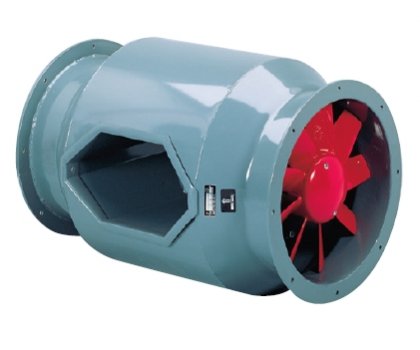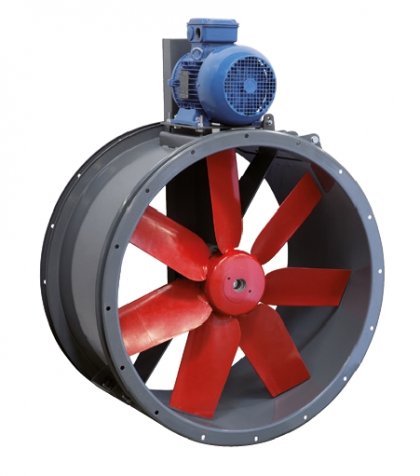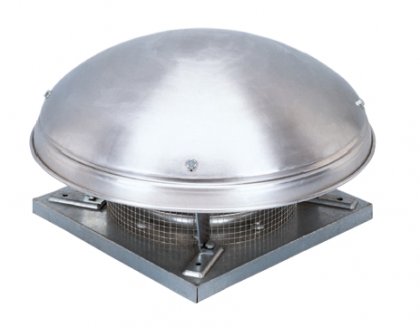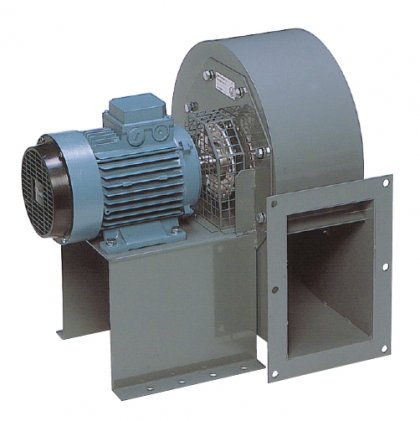The EDV range includes a range of fans suitable for industrial applications for exhaust air with a maximum temperature of up to 150 °C (or 120 °C). These include the TET, TTT N, CRMT, CSB/CST, CTHB/CTHT, CTVB/CTVT and other fans. Several rules apply to the use of the fans, the violation of which leads to damage to the fans and loss of warranty.
- The maximum temperature (120°C or 150°C) indicated by the manufacturer is the limit and cannot be exceeded even for a short period of time. Above this temperature, the lubricant will change state and the lubricating properties will be lost immediately. In addition, the high thermal expansion of the mechanical components leads to axial overloading of the bearings. We recommend operating temperatures up to approx. 20% below the maximum temperature.
- The maximum temperature value is cumulatively reduced in the following cases. For belt driven fans, if the belt is tensioned more than the manufacturer's recommendation. For all other fans, the maximum temperature value is reduced if there is insufficient cooling. The maximum temperature shall be reduced by the value of the error of the measuring method, the error of the measuring instrument including any transducers, etc. (cumulative error of the method, of the range and of the measured value). In addition to the above, a suitable safety factor must be applied, which is at the discretion of the designer and the specialist firm.
- Hot air must not pass through the fan unless the fan is in operation (in which case the bearings are not cooled and their lubricant degrades, as does the motor and other fan components).
- The fan must be protected when switched off, e.g. by a bypass, cool air supply by a mixing flap, etc. The fan can only be switched off after the hot air supply has been closed and the fan and components have cooled down to 40 °C. Alternatively, the fan must be protected e.g. by a bypass, cold air inlet with a mixing flap, etc.
- The ambient temperature of the fan can be a maximum of 40 °C to ensure sufficient cooling of its components. The fan must not be used for installation in closed uncooled technological units and equipment, in the linings of metallurgical and glassmaking technologies or furnaces, in cooling ducts for the removal of hot waste gases from technological processes, in unventilated ducts and furnace exhaust sumps, etc., without providing additional cooling. The fan shall not be thermally insulated. The specific assessment is the sole responsibility of the customer, the designer and the professional installer.
- The regulating device, which ensures that the maximum air temperature is not exceeded, must be designed by a professional company with knowledge of the technological process (heating and cooling time constants of the technology, temperature gradients in the air ducts, etc.).
- Temperature measurements must be made at the point of maximum air temperature or by a network of sensors throughout the fan cross-section, temperature sensors cannot be mounted on cooled parts of the technology or in parts of the ductwork where the hydraulic ratios result in lower velocity and thus greater cooling (fittings, arches, pockets without airflow). In straight duct sections the velocity increases continuously from the wall to the duct axis and measurement with a single short stem sensor cannot be recommended even for simple applications with small duct diameter and low flow velocity. For diameters of 500 to 800 mm, temperature differences can be significant (even more than 20 °C).
- Poor measurement methodology is one of the most common causes of failures. The evaluation of the measurement often does not respect either the technology as described above, the accuracy of the method and the measuring instrument, the accuracy and linearity of the transducers, etc. The error of the measurement method and the measuring instrument can be as much as 20 % cumulatively. Calibration curves are rarely available and the measuring equipment is not subject to verification by an authorised testing laboratory. Therefore, operating fans close to their maximum endurance limit often leads to failures.
- In the event of the fan being disconnected by a motor circuit breaker (phase failure in the installation and disconnection by undervoltage protection, disconnection by overcurrent relay, etc.), the switched-off fan must be protected by, for example, a bypass, a cold air supply by a mixing damper, etc.
- Speed control of fans intended for exhaust air with higher temperatures is not possible in principle. No speed controllers of any kind (frequency converters, transformer controllers, pulse-width or other) may be used. A reduction in speed leads to a reduction in the power (flow) of the auxiliary internal radial fans which cool the bearings, windings and magnetic circuits of the motor. Additional auxiliary fans on a common shaft cool the fan bearings and motor housing. Belt driven fans use the belt to transport air in the drive tunnel and to cool the impeller shaft bearings. Controlling high-temperature fans invariably results in damage to the fan or motor.
- Fans where the impeller is belt driven require the following conditions to be met. Belt tensioning must be carried out in accordance with the recommendations in the manual. Increased belt tension results in increased load on the bearings, their increased heating due to frictional forces and consequent shortening of their service life, in extreme cases even to the destruction of the bearings. Low belt tension leads to slipping of the gear, excessive heating of the gear and shortening of its service life.
- Periodic inspections of fans must be carried out according to the operating rules drawn up by the customer, the designer or a professional installation company and based on knowledge of the process equipment. Based on the revisions, it is necessary to determine the period of replacement of fan bearings, replacement and tensioning of belts, cleaning of the impeller and fan casing, etc.
- Assessment of specific technical conditions, suitability of fan use, selection of appropriate safety coefficients for fan sizing with respect to uncertainties of actual temperature detection in technologies, measurement and control inaccuracies, is always exclusively in the competence of the customer, the designer and the professional installation company.
Failure to comply with these basic conditions usually results in damage to the fans and loss of any warranty.
(Recommended References: Ventilation and Air Conditioning/Chyský, Oppl 1973, Ventilation and Air Conditioning Chyský, Hemzal et al. 1993, Heating and Ventilation/ Cihelka 1975)





